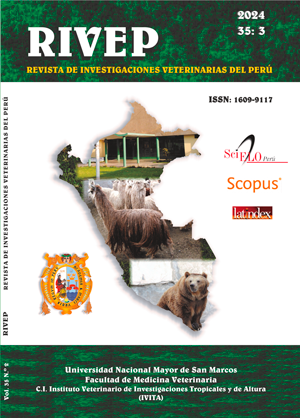Identification of helminth eggs in pet hamsters (Mesocricetus auratus and Phodopus sungorus) in Lima, Peru
DOI:
https://doi.org/10.15381/rivep.v35i3.28274Keywords:
hamster, Mesocricetus auratus, Phodopus sungorus, helminths, HymenolepisAbstract
The aim of this study was to evaluate the presence of helminth eggs in faeces of hamsters (Mesocricetus auratus and Phodopus sungorus) raised as pets for sale in shops in the centre of Lima, Peru. The study was descriptive, cross-sectional and prospective. Faeces from 63 pools of hamsters from four shops were evaluated with the concentration technique using the sugar-salt solution, during the months of May to July 2021. The helminth eggs were identified according to their dimension and morphology. Helminth eggs were identified in 60.5 and 36% of Syrian hamster (M. auratus) and Russian hamster (P. sungorus) pools, respectively. Syphacia spp was the parasite found most frequently (36.5%), followed by Aspiculuris tetraptera (7.9%). Hymenolepis spp was the only cestode and zoonotic parasite found.
Downloads
Downloads
Published
Issue
Section
License
Copyright (c) 2024 Christy Munoz-Huaman, Daniel A. Zárate Rendón, Raúl Zegarra V., Claudia Maguina-Molina

This work is licensed under a Creative Commons Attribution 4.0 International License.
AUTHORS RETAIN THEIR RIGHTS:
a. Authors retain their trade mark rights and patent, and also on any process or procedure described in the article.
b. Authors retain their right to share, copy, distribute, perform and publicly communicate their article (eg, to place their article in an institutional repository or publish it in a book), with an acknowledgment of its initial publication in the Revista de Investigaciones Veterinarias del Perú (RIVEP).
c. Authors retain theirs right to make a subsequent publication of their work, to use the article or any part thereof (eg a compilation of his papers, lecture notes, thesis, or a book), always indicating the source of publication (the originator of the work, journal, volume, number and date).



